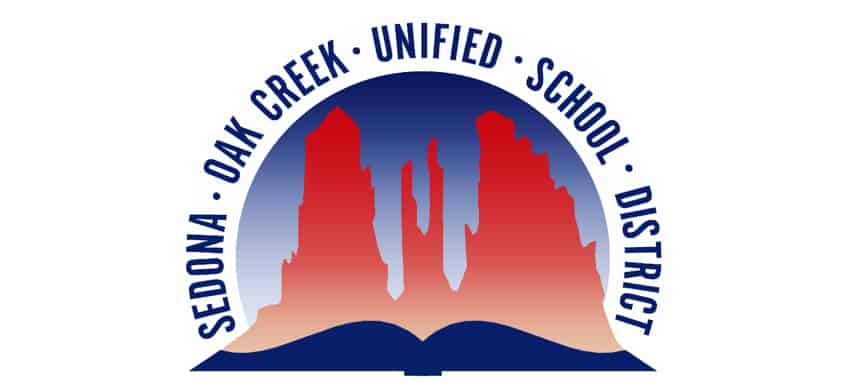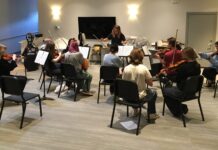Sedona-Oak Creek School District has released state test results and the news, by any measure, is not good. In a chart showing the percentage of students in a given grade who achieved a passing grade in English and Language Arts, not even half are passing in all grades.
The state of Arizona averages are not much better. Only two grades are above 50% statewide. Unlike many other states that use the Common Core federal standard, Arizona has its own unique testing instrument, Arizona Measurement of Educational Readiness to Inform Teaching, or AZMerit, arrived at by the Arizona Board of Education. In math, scores are even worse. In three grades only one in 10 students achieved a passing grade. The state of Arizona average is around four out of 10. The SOCSD administration said it has made no excuses and has already taken measures to turn things around.
“I tell our people daily … we don’t make excuses … we figure it out,” SOCSD Superintendent Dennis Dearden said.
AZMerit has been the test given to students annually since 2015. This year the state has not released the results online but left it up to individual districts.
“Last year the Arizona Legislature allowed schools to choose levels of assessment. You could either give AZMerit, the SAT or the ACT,” said Deana DeWitt, SOCSD assistant superintendent and director of curriculum and instruction. “We chose to stay with the AZMerit simply because with the consistency we’re better able to measure our growth if we’re using the same instrument.”
“My reaction to the test scores is simple. We have work to do,” West Sedona School Principal Brenda Cady said. “Test scores do not lie, but they do not tell the whole story either. State standardized scores are one data point out of many that fuel our continuous improvement efforts.”
“Those scores reflect room for growth, there is no doubt about it,” DeWitt said. “It’s simply to inform our instruction. We know that one snapshot on one day a year does not tell the whole story.”
2019 AzMerit
English/Language Arts
Percentage passing
Grade SOCSD State
3 21% 46%
4 26% 51%
5 21% 52%
6 41% 42%
7 42% 41%
8 37% 38%
9 26% 37%
10 38% 34%
11 40% 34%
Mathematics
Percentage passing
Grade SOCSD State
3 36% 51%
4 13% 48%
5 7% 46%
6 30% 41%
7 31% 38%
8 11% 32%
April for last year’s classes. Results show improvement year-to-year in tracking the same class cohort from third-graders in 2016 to who were sixth-graders in April 2019.
Known as longitudinal data, cohort tracking shows regression or growth. From 2016 to 2019, longitudinal gains were made at grades three through 11.
“That’s where you’re going to see improvement. But if you look at cohort growth from one year to the next, we can celebrate some growth in those areas,” DeWitt said.
But measuring test scores over multiple years is difficult when Arizona’s tests continue to change. SOCSD used the Arizona Instrument to Measure Standards test from 1999 to 2014. Subsequently, there have been five different instruments at the state and federal level, including three different Arizona tests, making comparison of results across many years difficult. Additional evaluation of the scores shows vulnerability in the lower grades. Students struggling to achieve passing scores in grades three through six are especially evident. Cady said she has already adopted an aggressive approach to the problem.
“We have put in place academic teams and operational teams to continually analyze our current needs, celebrate successes and make decisions based on data,” Cady said.
“At the high school level … our teachers get to concentrate on one content, they’re usually content specialists,” DeWitt said. “In the elementary level for all those tested subjects …. You’re the science expert, the math expert, the language arts expert for the children that you serve and that’s a heavy burden.”
Judging the school district on these results reveals hurdles unique to Arizona schools, DeWitt said. SOCSD variables for testing show:
- Changing standards
- Different state tests
- Teacher turnover
- Administrative turnover
- Class transiency — students leaving Sedona- Oak Creek School District
- English language learners
The standard test to measure achievement has changed many times as have the requirements. Even the AZMerit test, now the standard, has changed again for 2019-2020.
2019 AzMerit Improvement Over Time
English and Language Arts
This is the longitudinal measure, the percent of passing scores a single cohort, current sixth-graders, as they progressed from third to sixth grade
Cohort by year percentage passing :
2016 32%
2017 38%
2018 41%
2019 41%
Testing Standards
1999: Arizona Instrument to Measure Standards, aka AIMS.
2000: No Child Left Behind federal standard.
2010: Arizona Board of Education adopts Common Core.
2014: AIMS standard discontinued.
2015: State adopts Arizona Measurement of Educational Readiness to Inform Teaching, aka AZMerit.
“We were just notified by the state board of education that AZMerit testing at the high school level will only count for 10th grade,” DeWitt said. “We want to be able to use the data … but when we are shooting for a moving target, it’s really challenging to rely on this measure.”
Sixteen new teachers were hired this year, many of whom were hired when previous teachers moved away or retired. The district hired a new superintendent in 2018, and changed principals twice in three years at SRRHS. Even the student body has undergone turnover. The cohort that arrived at SRRHS in 2015 was fewer than 70 students, but in the course of the next four years, more than 500 enrolled and exited. Then there is the issue Arizona and other border states have to struggle with when measured against other schools across the country. English Language Learners are students who cannot pass tests for speaking English at the same level of their native English-speaking classmates. While the school district will not assign a percentage to the number of ELL students, it is an increasing struggle.
“Our high demographics of English Language Learners does present challenges for the individual student, but also varies from student to student with both successes and struggles,” Cady said.
“We know that our ELL population is growing … we know that our special education population is growing, and we need to be able to meet those special needs in our classrooms,” DeWitt said.
Last year, the Arizona Board of Education issued letter grades to school districts in Arizona. After 2018, SOCSD got a cumulative C. The Arizona Board of Education announced Sept. 23 that their letter grade system from A to F has been postponed until officials can agree on a new model to judge results.
Don Eicher can be reached at 282-7795 ext 126 or by email at deicher@larsonnewspapers.com





















